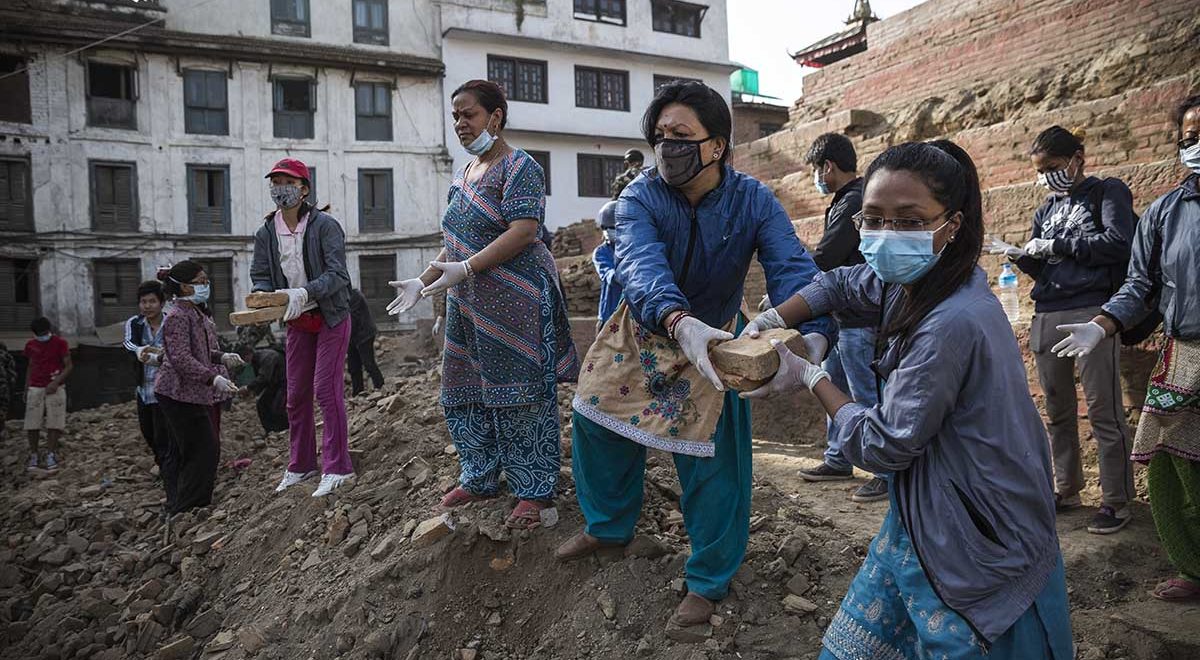Three years ago on Wednesday, Nepal was hit by a huge earthquake. Nearly 9,000 people lost their lives, and hundreds of thousands of homes and businesses were destroyed.
I was in Nepal only a few months ago and the impacts of the earthquake are still clearly visible. Walking through the streets of the capital Kathmandu, you can still see buildings with huge cracks down the sides that await repair. Many visitors will only see the temples in the tourist center of Durbar Square that are still closed off, but let’s not forget that it was the poorer parts of the city and the surrounding areas that were hardest hit.
When the earthquake struck, our local teams sprang into action and were among the first to respond. They reached more than 130,000 people with emergency relief items, including food, drinking water and tarpaulins for building temporary shelters.
We’ve worked in Nepal since 1983, together with networks of women across the areas affected by the earthquake. These women took the lead in all our relief distribution work, identifying the worst affected families within their communities and getting them what they needed, fast.
As time has passed, we’ve shifted from emergency response to supporting communities to build back stronger. Here are some of the main things we’ve been doing:
Making sure women’s rights are respected
In the immediate aftermath of the earthquake, we set up safe spaces where women could come and receive specialist support from our trained counselors. As time has gone on, we’ve expanded the number of safe spaces to 30. Each center has a referral process through which women can report instances of violence. They’ve also been an important part of the reconstruction process, providing a space where women can get together and identify their needs, and get the tools and information to engage in the rebuilding process.
Women attending the centers have also received leadership training and support setting up small businesses like mushroom farms that can help to boost their incomes.
Supporting communities so they’re equipped to respond to future emergencies
Making sure that people can rebuild their homes and businesses has been a core part of our long-term response. We’ve formed 137 Community Reconstruction Committees that are taking forward the reconstruction of homes, as well as public buildings like schools. But we’ve also been working to make sure that communities are better prepared to face any future emergencies.
We’ve worked with communities across 18 areas affected by the earthquake to put in place Local Disaster and Climate Resilience Risk Management Plans. We’ve also organized emergency response trainings so that families can learn more about security and safety procedures for when a disaster happens, and what they should do.
Making sure that land rights are respected
It’s easy to underestimate the impact of a large-scale disaster like the Nepal earthquake. Not only were people’s homes and businesses destroyed, and loved ones’ lives lost, but a lot of documentation will have been lost.
When a huge earthquake hit Haiti in 2010, the Land Ministry was destroyed and many people lost their land deeds. As the rebuild got underway, there were many reports of people’s land being taken and families left without land. That’s why we make protecting people’s land rights part of our emergency response work.
In Nepal, we set up 38 Land Rights Forums which have been working to make sure that people’s land rights are respected. Since the committees were set up, we’ve supported communities to make sure that public land is used in ways that meet their most urgent needs and helped landless farmers get access to land.
But there’s still more to do
Our team continues to work closely with many of the communities impacted by the earthquake. In the coming months, we’ll be making sure that reconstruction of schools and other infrastructure projects are finished. We’re continuing to work with Community Reconstruction Committees to make sure that the disaster response plans are developed and that people know what to do if another earthquake hits. We’re also playing a watchdog role, together with other organizations working in different areas of the earthquake zone, making sure that communities have access to government grant processes that provide money for reconstruction.



